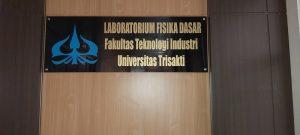Contact Us
- JL. Kyai Tapa No. 1 Grogol
- Jakarta Barat, Indonesia
- Phone:
- (62-21) 566 3232
- Whatsapp:
- (+62) 882 194 856 74
- (+62) 877 707 077 03
- Fax: (62-21) 564 4270
- Email: humas@trisakti.ac.id

1. Introduction
The Physics Laboratory is a fundamental laboratory directly under the Faculty of Industrial Technology. The Physics Laboratory serves all physics practicums and lectures within the scope of FTI and beyond FTI within the scope of Universitas Trisakti.
For the scope of FTI, the Physics Laboratory serves the Mechanical Engineering, Electrical Engineering and Industrial Engineering Study Programs, while the Physics Laboratory serves the Faculty of Earth and Energy Technology, including the Petroleum Engineering, Geological Engineering and Mining Engineering Study Programs and the Faculty of Landscape and Environmental Engineering for the Environmental Engineering Study Program.
Physics, as a fundamental science in engineering, is a crucial subject for students in the Faculty of Engineering because it lays the foundation for understanding subsequent engineering disciplines. Understanding physics cannot be solely achieved through literature or lectures, it requires experimentation and practical demonstrations of physical phenomena. Therefore, basic physics laboratories are an integral part of fundamental physics courses.
In the physics practicums for FTI students, the provided practicum modules have been tailored to the development and industry needs. Thus, the Physics Laboratory not only serves as a practicum facility but also supports internships, contributes to students’ final projects, and serves as a venue for research and community service by physics faculty members and students.
2. Structure and Personnel
In its operation, the Physics Laboratory is managed by a Head of the Laboratory, assisted by a Practicum Coordinator who is coordinated by a Practicum Coordinator. The personnel in the Physics Laboratory are as follows:
Head of Laboratory : Drs. Bambang Cholis Su’udi, MSc.
Practicum Coordinator : Drs. Bambang Cholis Su’udi, MSc.
Head of Practicum in Physics Mechanics : Drs. Muhammad Najih, MSc.
Head of Thermophysics Practicum : Drs. Muhammad Najih, MSc.
Head of Electricity & Magnetism Physics Practicum: Larasati Rizky Putri, SPd, MPd.
Head of Optics and Sound Physics Practicum : Ika Wahyu Utami, SSi., MSc.
Laboran/Technician and Administration : Benny Wahyuni, SSi.
3. Course Learning Outcomes (CPMK)
After completing the Physics Practicum, participating students (practicum participants) can:
4. Practicum Service
The procedure for conducting physics practicums:
5. Practicum Implementation
In general, the implementation of practicums by students will follow the sequence below:
Some Codes, Titles and Objectives of Experiments in the Physics Laboratory include:
No. Code Practicum Title and Experiment Objectives
| No. | Kode | Judul Praktikum dan Tujuan Percobaan |
| 1. | M-5T | Liquid Viscosity, with the Experiment Objective: Determine the viscosity coefficient of lubricating oil using the Ostwald viscometer. |
| 2. | M-7 | Spring Force Constant, with the Experiment Objective: Determine the spring force constant using Hooke’s Law. Determine the spring force constant through spring oscillation |
| 3. | B-1B | Sound Resonance with Oscilloscope, with Experimental Objectives: Determine the speed of sound propagation in air and the frequency of the sound source. |
| 4. | P-7B | Mechanical Heat Tare, with Experimental Objectives: Observe the process of converting mechanical energy into heat and determine the mechanical heat rate. |
| 5. | L-2 | Characteristics of Incandescent Lamps, with Experimental Objectives: Determine the relationship between current and voltage in a lamp and determine the relationship between power and voltage in an incandescent lamp |
| 6. | OP-1 | Lens Focal Length, with the Experiment Objective: Determine the positive lens focal length using 4 methods. Determine the negative lens focal length. |
| 7. | MG-1 | Magnetic Field of Loop Wire, with the Experiment Objective: Prove Biot Savart’s Law. Determine the magnetic field of a loop wire as a function of the number of turns and the radius of the loop wire. |
| 8. | MG-3 | Magnetic Field of a Straight Current Wire, with Experimental Objectives: Determine the magnetic field of a straight wire as a function of distance for two parallel straight wires and determine the magnetic field of a straight wire as a function of distance for two anti-parallel straight wires. |
| 9. | M-11B | Moment of Inertia and and Torsional Vibration, with Experimental Objectives: Determine the angular recovery constant of a conch spring and determine the moment of Inertia of various shapes of objects. |
| 10. | M-15 | Law of Conservation of Mechanical Energy, with Experimental Objectives: Determine translational and rotational kinetic energy and prove the Law of conservation of Mechanical Energy. |
6. Grading Weights:
7. Physics Practicum Reference Books